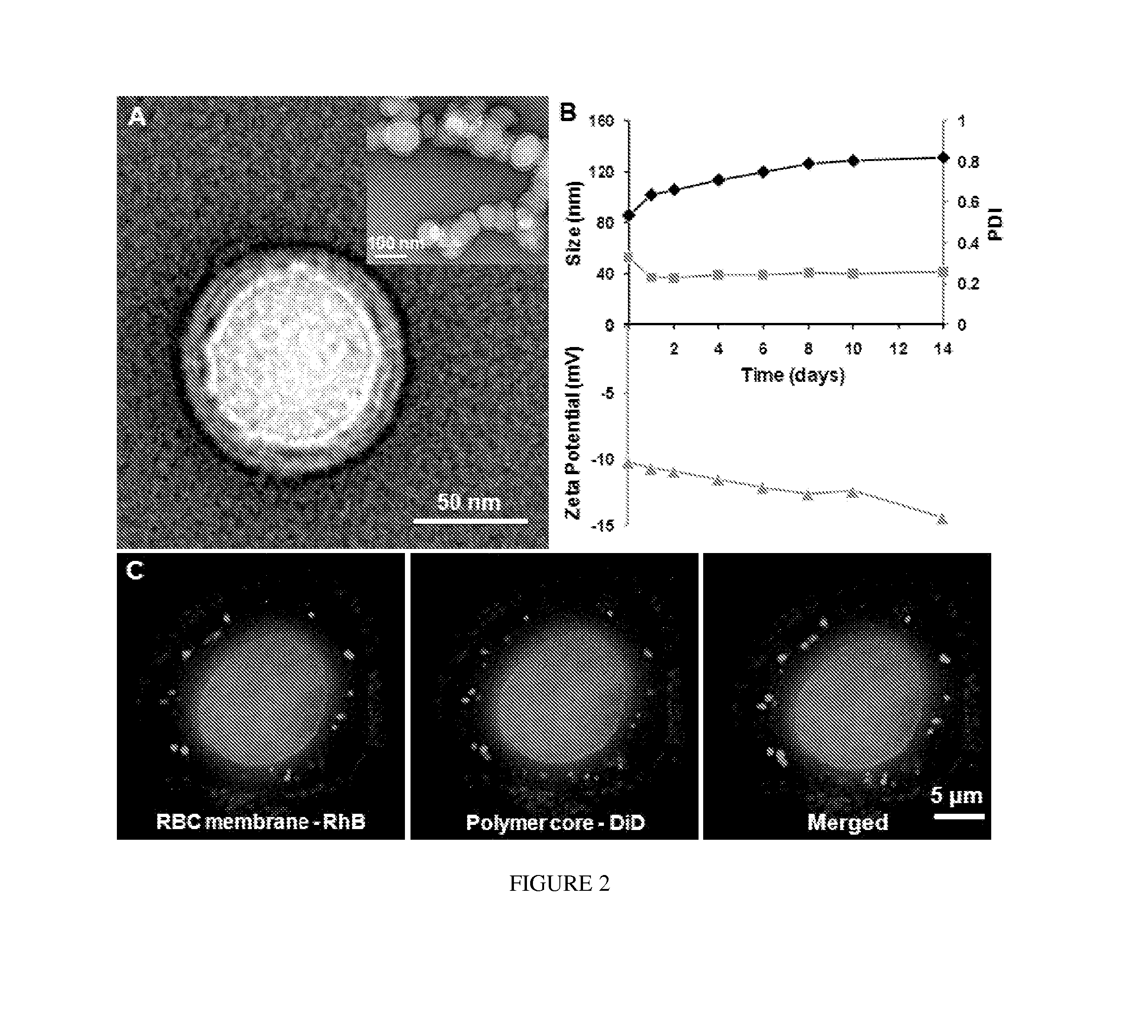Membrane Encapsulated Nanoparticles and Method of Use
a membrane encapsulation and nanoparticle technology, applied in the direction of antibody medical ingredients, immunological disorders, antibacterial agents, etc., can solve the problems of rbc-mimicking delivery vehicle remained elusive for biomedical researchers, difficult to functionalize nanoparticles with the complex surface chemistry of biological cells, and largely inadequate bottom-up approaches
- Summary
- Abstract
- Description
- Claims
- Application Information
AI Technical Summary
Benefits of technology
Problems solved by technology
Method used
Image
Examples
example 1
Erythrocyte Membrane-Camouflaged Polymeric Nanoparticles as a Biomimetic Delivery Platform
[0238]By extruding poly(lactic-co-glycolic acid) (PLGA) particles with preformed RBC membrane-derived vesicles, inventors coat the sub-100 nm polymeric particles with the bilayered RBC membranes including both lipids and the corresponding surface proteins. This approach aims to camouflage the nanoparticle surface with the erythrocyte exterior for long circulation while retaining the applicability of the polymeric core. The inventors report the physical characterizations, physicochemical properties, protein contents, pharmacokinetics, and biodistributions of this biomimetic nanoparticle delivery platform.
[0239]The preparation process of the RBC membrane-coated nanoparticles is divided into two parts: membrane vesicle derivation from RBCs and vesicle-particle fusion (FIG. 1). The derivation of RBC membrane vesicles follows a previously reported method with slight modifications (13). Briefly, RBCs...
example 2
Erythrocyte Membrane-Cloaked Polymeric Nanoparticles for Controlled Drug Loading and Release
[0314]Polymeric nanoparticles (NPs) cloaked by red blood cell membrane (RBCm) confer combined advantages of long circulation lifetime and controlled drug retention and releases. Toward the development of this cell-mimicking NP platform for advanced drug delivery applications, herein, the inventor carried out studies to gain better understandings on its drug loading, drug release kinetics, and cell-based efficacy. Specifically, to study drug releases from RBCm-cloaked NPs, the inventor compared two strategies for loading doxorubicin (DOX), a model anti-cancer drug, into RBCm-cloaked NPs: physical encapsulation and chemical conjugation. In vitro efficacy was examined by using acute myeloid leukemia (AML) Kasumi-1 cell line.
[0315]The inventors found that chemical conjugation strategy resulted in a more sustained drug release profile. Furthermore, by formulating PEGylated NPs of the same polymeri...
example 3
Nanoparticles with Cancer Cell Membranes for Personalized Immunotherapy
[0382]The present example provides a immunotherapeutic system that has several advantages over existing approaches.
[0383]1) Current strategies concentrate only on individual tumor associated antigens (TAAs) that are expressed by the general cancer type in question. Cancer is a heterogeneous disease, and one limitation of such an approach is that the antigen expression of one patient's cancer could be completely different from another's. This leads to a less than optimal percentage of patients who are actual candidates for receiving such treatments. Another concern is that targeting a single TAA leads to a weak overall immune response against the cancer, allowing it to ultimately mutate and develop resistance. The described invention solves these problems by tailoring the treatment towards each individual patient via the collection of membrane material from their autologous tumors. This approach allows the accurat...
PUM
| Property | Measurement | Unit |
|---|---|---|
| Time | aaaaa | aaaaa |
| Composition | aaaaa | aaaaa |
| Energy | aaaaa | aaaaa |
Abstract
Description
Claims
Application Information
 Login to View More
Login to View More - R&D
- Intellectual Property
- Life Sciences
- Materials
- Tech Scout
- Unparalleled Data Quality
- Higher Quality Content
- 60% Fewer Hallucinations
Browse by: Latest US Patents, China's latest patents, Technical Efficacy Thesaurus, Application Domain, Technology Topic, Popular Technical Reports.
© 2025 PatSnap. All rights reserved.Legal|Privacy policy|Modern Slavery Act Transparency Statement|Sitemap|About US| Contact US: help@patsnap.com



